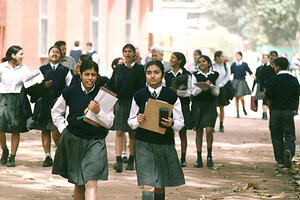Gender selection: In India, abortion of girls on the rise
Gender selection via abortion appears to be on the rise in India – and more common among the wealthy. India's upper classes tend to have fewer children and more access to ultrasounds that reveal their babies’ sex. The gender imbalance means fewer women available to be wives.

Female Indian students come out from a school in New Delhi, shown in this file photo. Gender selection via abortion appears to be on the rise in India.
TC Malhotra/ZUMA Press/File
Nandgaon, India
Babulal Yadav, a 50-year-old farmer, has revised his notions of the perfect wife. “I don’t mind what caste she is, what religion, or what she looks like anymore,” he says. “I just want a nice girl to look after me and give me a son.”
It is precisely this attitude toward gender selection that made it difficult for Mr. Yadav to find a wife. A preference for boy babies has resulted in a dearth of brides for the men of his rural village. Increased access to ultrasound technology, which allows parents to abort unwanted baby girls, has contributed to a female-male ratio of 933 to 1,000 in India according to the latest census, from 2001.
But Yadav’s prospects are especially dim because he lives in the relatively prosperous Haryana, the state with the most skewed female-male ratio in the country: 861 to 1,000.
Indeed, across India the most skewed gender ratios tend to occur in more prosperous communities. Far from being an ancient legacy of backward, chauvinistic communities, the practice of gender selection via abortion (also known as female infanticide or female feticide) is flourishing as India’s economy burgeons and the country modernizes. In the capital, New Delhi, the gender ratio is more unbalanced than the national average, with 821 females to every 1,000 males. Some of the greatest imbalances occur in the wealthy neighborhoods of south New Delhi.
And recent research suggests gender selection abortion is on the rise. Actionaid and Canada’s International Development Research Centre found in 2008 that in 4 of the 5 states surveyed – Punjab, Haryana, Madhya Pradesh, and Himachal Pradesh – the proportion of girls to boys had fallen further. In some areas of Punjab, among high castes, the ratio of girls to boys was 300 to 1,000.
Daughters believed to cost more
The reasons why boys are so longed for vary somewhat by region. In agricultural societies like Nandgaon, boys inherit the land. In urban India, a trend toward smaller families plays a part: Many couples who choose to have only one child want that child to be a boy.
Underlying the preference for sons is a belief that girls are liabilities who require protection and fat dowries. Though the practice of paying a husband and his family for marrying a girl was banned in 1961, dowry violence – when a woman is abused in her in-laws’ home for paying an insufficient price – is on the rise, according to nongovernmental organizations (NGOs).
Even in families that do not pay dowries, and where girls may be well educated and lucratively employed, females tend to be viewed as burdensome because they are perceived as requiring more care and protection than men, says Puneet Bedi, an obstetrician and campaigner against female feticide based in New Delhi.
“Everyone wants boys – not just the rich,” he says. “But it is the rich who can easily afford to access the technology.”
Though it is illegal in India for a doctor to tell parents the gender of their unborn child, or to abort on the grounds of sex, there have been almost no prosecutions for the crime. It is carried out “by every doctor with almost no exception,” says Dr. Bedi.
“Save the girl child” campaigns launched by both governments and NGOs have raised people’s awareness about the issue of female feticide, but apparently done little to change their behavior.
(The Monitor wrote about China's gender imbalance. You can read that here.)
Budding appreciation for girls?
There are hopes that the effects of a skewed sex ratio now becoming dramatically visible in places like Nandgaon will make parents reassess their urge to abort baby girls.
Villagers here say that the dearth of females has already had a direct effect on dowry customs: Dowries are getting smaller or disappearing altogether; instead, the onus is increasingly on young men to provide well for their future brides.
So bad are the romantic prospects of many bachelors in Haryana that they have started to take a step unthinkable a generation ago: importing women from other states, and often religions, to marry.
The Red Cross Society of India, which campaigns against female feticide across the country, estimates that at least 100 women from outside Haryana have been bought by men in the district of Bhiwani, one of Haryana’s 21 regions. In Nandgaon, at least five brides have been imported from other states.
Baljeet Singh, a 37-year-old truck driver, says he began to despair of finding a local wife once he turned 26. Men in this village, where most are farmers, consider it ideal to wed between 20 and 25. “I’m a van driver, I don’t have many prospects, and it seems that you have to have a very good job to get a bride these days,” he says.
So last year, Mr Singh used his life savings to marry a 16-year-old Muslim girl from Assam; though village rumors have it that Sonu Khutum is an illegal immigrant from Bangladesh. She is happy to be living in a predominantly Hindu village, she says, joggling the couple’s 7-month-old baby girl on her hip.
But lonely bachelors’ new quick fix, buying brides from impoverished parts of India, seems likely to do little to enhance the status of women.
Since Singh married, single friends have been lining up for matrimonial advice. They have one question, he says, as he gestures toward his young wife, who stands shyly in a corner: “How can I get one?
-----
